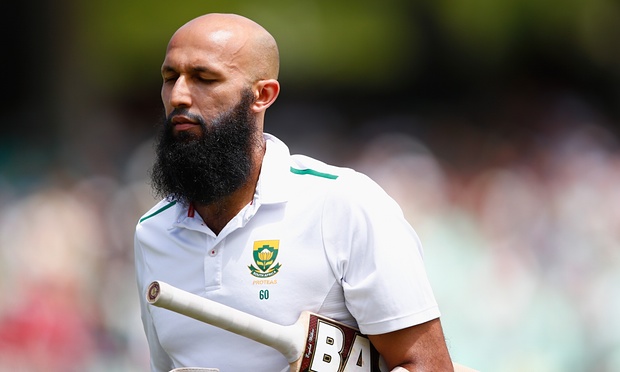



Hashim Amla took time out from announcing his departure as captain to praise Temba Bavuma after the 25-year-old became the first black player to score a century for South Africa. Photograph: Julian Finney/Getty Images
You don’t look like me in this world without being firm in what you want to do,” said Hashim Amla, during the press conference in which he announced his resignation as South Africa’s Test captain after 18 months in charge. While it was in response to suggestions that when taking the job in mid-2014 he had done so under duress, it neatly summed up the determined man that lies behind the calm exterior and the flowing beard.
Amla leaves the role with his side 1-0 down to England but with his head held high and will continue as a highly feared batsman. Better to step aside with a chance of victory remaining, he said, than hinder their chances further. He believes his best role is guiding younger players in the side as a senior player, not a captain.
While the 32-year-old addressed concerns over his form with 201 in South Africa’s first innings in Cape Town, he surprised many with the timing of his resignation, as well as the fact it was not, as in previous years, the Englishman falling on his sword. But, when considering South Africa’s rotten 2015 and his own past record as a leader, it always felt on the cards.
Amla had already walked away from two such roles during his career, leaving the captaincy of his former franchise, the Dolphins, in 2005 after only one season in charge before stepping down from South Africa’s one-day vice-captaincy two years ago. Both times he said it was to concentrate on his batting.
Here it was the same reason, Amla admitting he had been considering his position before the series but, given the quick turnaround from the 3-0 series defeat to India at the start of December, felt it best to wait and see. After a period of introspection, as he called it, he decided someone else was better suited to the job.
In the short term South Africa have turned to AB de Villiers, their premier batsman and one-day captain, to see out the series. But as a long-term successor, doubts will remain about his interest despite the head coach, Russell Domingo, describing him as the frontrunner at present. Come the third Test in Johannesburg on 14 January, De Villiers will have gone from wicketkeeper to batsman to captain in the space of three weeks, the first of which saw him making noises about lessening, not increasing, his workload.
After the draw at Newlands, he at least inherits a team with some confidence restored. The crushing defeat in the first Test led to talk of a gulf between the two sides and yet come the fifth day in Cape Town, despite Alastair Cook’s batsmen amassing 629 for six in their first innings, South Africa were only side who could win. Amla and Faf du Plessis returned to form with the bat but perhaps the most heartening performance came from Temba Bavuma, the 5ft 3in right-hander who became the first black player to score a century for South Africa with his unbeaten 102, an innings of considerable promise.
It was a historic moment for the country and one which was not lost on Amla, as he took time away from fielding the questions about his own news to highlight that, in making those runs, Bavuma had given an answer to those questioning whether his inclusion was in the main down to his colour.
“We have similar starts to our careers, with people doubting you because of the colour of your skin or various reasons. And I know the pressure players of colour go through. We know how talented he is and it was a victory for the Proteas because it shows the team environment is in a good place.”
Amla averaged 25 after the first 15 Tests of his career but sits with that number at 51 after his 90th, and while he may not be a natural leader of a team, as a dressing-room role model he will continue to be invaluable. theguardian.com